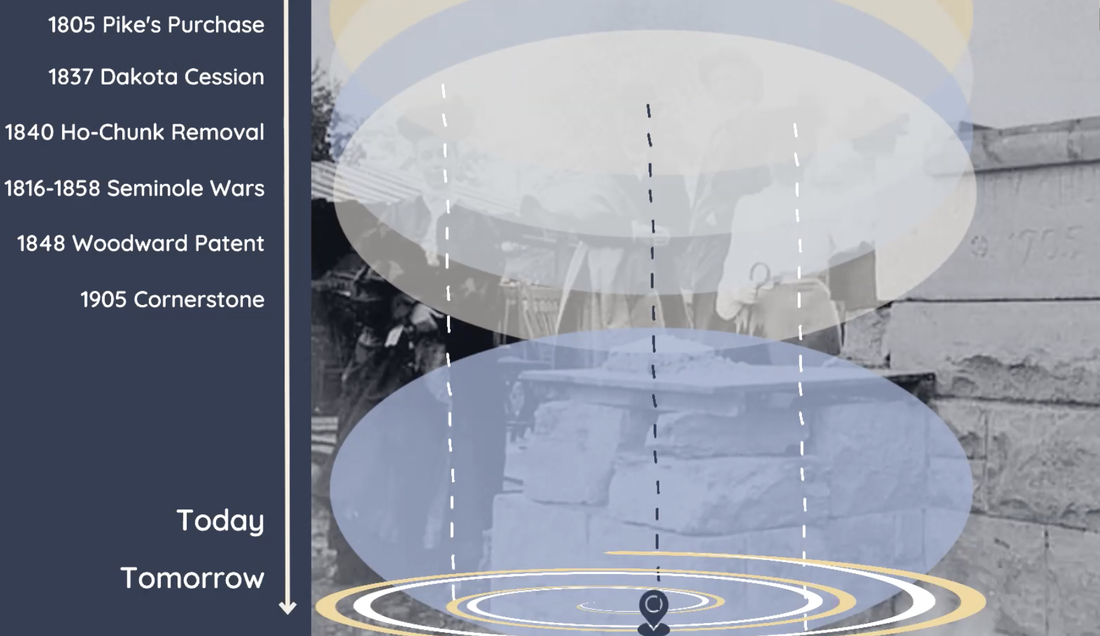|
Rebecca Gonzalez-Campoy, Beloved Community Communications and Indigenous Justice Ministry Teams Unity Church-Unitarian sits on land stolen from the Dakota people. We read this in our weekly Order of Service and proclaim it prior to the start of most church meetings, our own pledge of allegiance of sorts. However, what does this really mean and how did it happen? Unity’s Act for the Earth and Indigenous Justice Community Outreach Ministry Teams series, “Truth Telling and Healing: Indigenous and Environmental Justice," included a close look at how Unity came to be located on Dakota land (Land and Reparations). During this presentation in March 2023, Jessica Intermill of Minnesota Interfaith Power and Light and Intermill Land History Consulting, invited us to look at history differently. Unity Church-Unitarian sits on land stolen from the Dakota people. We read this in our weekly Order of Service and proclaim it prior to the start of most church meetings, our own pledge of allegiance of sorts. However, what does this really mean and how did it happen? Unity’s Act for the Earth and Indigenous Justice Community Outreach Ministry Teams series, “Truth Telling and Healing: Indigenous and Environmental Justice," included a close look at how Unity came to be located on Dakota land (Land and Reparations). During this presentation in March 2023, Jessica Intermill of Minnesota Interfaith Power and Light and Intermill Land History Consulting, invited us to look at history differently. History is typically laid out chronologically in books: American Revolution, Slavery, Western Expansion, and the Civil War. However, slavery occurred before and during the Revolution and played a part in westward expansion. “Today’s physical landscape has everything that came before us right now,” explained Intermill. The question is, “What does it mean to take responsibility for a past that’s not past?” Intermill mapped the location of Unity Church and then peeled back the layers of events on our land since the occupation of stolen Dakota land. She started with the arrival of United States General Zebulon Pike at the convergence of the Minnesota and Mississippi Rivers who declared it an ideal spot to build a fort (Fort Snelling). In 1805, the United States Congress purchased from the Dakota people 155,000 acres of land at this spot for practically nothing. Through deception and manufactured devaluation, land that should have brought $300,000 to the Dakota people possibly brought them the remains of $2,000 worth of goods. Keep in mind that Bdote, the convergence of these two rivers, is where human life began according to the Dakota. So, this is sacred land which started out as a place of genesis and eventually became the site of genocide. Things didn’t fare any better when the U.S. government purchased more land surrounding Fort Snelling through the 1837 Sioux Treaty. Here again, treacherous cruelty prevailed — this time the Dakota only received $16,000 through this treaty while those who had intermarried with them received $110,000, and $90,000 covered fabricated Dakota debt created by white people (many of whom were of the federal government). This thievery stemmed from the demise of the fur trade and a need for those traders to come up with a new source of income. From there, the U.S. government paid soldier Sam Taylor for his work with a New York regiment with a voucher for a section of land between St. Clair and Marshall Avenues. Taylor didn’t want the land and sold it to land speculators, and it eventually wound up in the possession of a man named Woodword. So, back to Intermill’s original question: “What does it mean to take responsibility for the past that’s not past?” Participants in the final session in the Truth Telling and Healing series held last month shared their stories of how the programs had impacted them. These are some of the themes that emerged:
The group then considered next steps for themselves as individuals and for Unity as a congregation:
Among the suggested resources to continue the Indigenous and environmental justice journey is the Native Governance Center's Beyond Land Acknowledgment Guide. This is one avenue Unity’s Indigenous Justice Community Outreach Team will explore as it plans future learning and spiritual growth opportunities. Be sure to also check out Act for the Earth activities. Meanwhile, continue your own spiritual and educational journey by exploring:
0 Comments
|
Topics
All
Beloved Community ResourcesUnity Justice Database
Team Dynamics House of Intersectionality Anti-Racism Resources in the Unity Libraries Collection Creative Writers of Color in Unity Libraries The History of Race Relations and Unity Church, 1850-2005 Archives
July 2024
Beloved Community Staff TeamThe Beloved Community Staff Team (BCST) strengthens and coordinates Unity’s antiracism and multicultural work, and provides opportunities for congregants and the church to grow into greater intercultural competency. We help the congregation ground itself in the understanding of antiracism and multiculturalism as a core part of faith formation. We support Unity’s efforts to expand our collective capacity to imagine and build the Beloved Community. Here, we share the stories of this journey — the struggles, the questions, and the collaborations — both at Unity and in the wider world.
The current members of the Beloved Community Staff Team include Rev. Kathleen Rolenz, Rev. KP Hong, Rev. Lara Cowtan, Drew Danielson, Laura Park, Lia Rivamonte and Angela Wilcox. |
